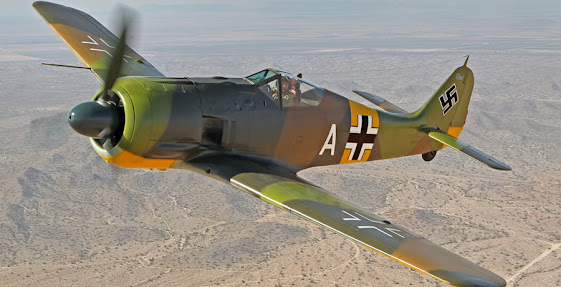1. Supermarine Spitfire - The Great Britain
This marvel of British engineering was also the British spirit summed up in a magnificent machine during World War II. It was powered by a Merlin Rolls-Royce engine.
Rapid rearmament of Germany pushed for furthering the Royal Air Force. R.J. Mitchell was assigned to produce a new generation of aircraft alongside a cadre of Aerodynamicists, Structural Engineers, Mathematicians, Metallurgists etc.
Prototype was successfully examined in 1936, Mark-1 was commissioned in 1938 before the Invasion of Poland. Mark-1 raced at 390 KM/h, when it was Mark-24 it was 731 KM/h.
The best feature of the aircraft was Turns and Maneuvering aptness. It was sensitive and could easily out-turn its front runner. It was upgraded and improved over time to tone with rivals.
Much before power steering became a trend in motor transport, power assisted maneuvering was adjoined which maintained it's loftiest rank among the aircrafts.
The prime actions from Spitfire were seen during the Battle of Britain (1940) against the German Luftwaffe. Alongside the older Hawker Hurricane, it maintained British air supremacy. The Messerschmitt BF 109 was trailed by Spitfire while the leisurely Bombers were handled by Hurricane. Britain was secured because of the Spitfire assisted by Hurricane against the Luftwaffe. Spitfire also saw several actions in occupied French.
Out of 20,351 Spitfires, 60 are still airworthy.
"It looks good, It is good" - R.J. Mitchell
2. Focke- Wulf Fw 190 (The Butcher Bird) - Germany
When the aircraft was introduced in August 1941, a lethal amalgamation of maneuverability and speed startled RAF Spitfire, considered a top performer at that time earning nickname 'The Butcher Bird'.
Powered by a BMW 801 engine, it was the brainchild of German Aeronautical Engineer Kurt Tank. It was air-cooled , thus improving robustness of the aerial dogfights. The aircraft was used as Bombers, Reconnaissance fight, Torpedoes' Attack etc. The aircraft was powered by BMW engine which was air-cooled. It was used as reconnaissance flight, bomber and for torpedo attack.
Against the USSR in the Eastern Front, it saw numerous victories against delicate Soviet Air Defence Forces.
The aircraft was admired for Speed, Maneuverability and Multiple tasking. It also had vices, foremost was toiling above 6000 meters in aerial dogfights.
3. Republic P-47 Thunderbolt - U.S.A
The aircraft was designed by Alexander Kartveli, a year after the Japanese invasion of the American Naval fleet at Pearl Harbor. It was not as sleek as the Spitfire or had aerodynamic design like P-51 Mustang, It was Chunky and Thick which earned nicknames such as ‘Flying Bathtubs’ or popularly known as ‘Jugs’.
Ace Pilots were the fighter pilots credited with shooting down more than five enemy aircrafts in aerial dogfights. An American Ace pilot Gabby Gabreski, also earned his prominence flying P-47.
The P-51 became a symbol of the American Airforce in World War II because of the latter-day design and it was also glamoured.
Statistically, the P-47 Thunderbolt was a cut above the P-51 Mustang. The Rolls Royce Merlin engine was the impetus for the aircraft. It could fly at much higher altitude. It could be chastised and not be dissuaded after thumping punishment in aerial dogfights.
4. Mitsubishi A6M Zero - Japan
The plane was the primary aircraft of the Imperial Japanese Navy in World War II, the predecessor of the aircraft was the A5M which was used in the Chinese invasion. The aircraft was improvised from the experience it had acquired in the Chinese theater before world war II.
The aircraft was also called The Type 0 since the Japanese year that time was 2600 (Julian Calendar 1940). The basis on the development of The Zero was Maneuverability and Range, it had to easily out-turn enemy aircrafts and travel as far as China and return the same day. It was powered by Nakajima Sakae Engine and the material was recently developed using secret aluminum alloy called ‘extra super duralumin”.
Zero was introduced in China to fight American volunteer fighters and in the Pacific where it out-powered and out-turned American Warhawks. Even Spitfires and Hurricanes which saw fresh victory in Europe found it hard to challenge the Zeros. It was mostly involved in the pacific and China.
Zeros were not equipped with radios to reduce weight which meant that communication between the pilots was impossible. Pilot armored casing protection from enemy fire during the dog-fight was also substandard. When the war was nearing end, Zero development and upgradation ceased.
Kamikaze Pilots used Zero to launch suicide attacks on the enemy naval fleets.
5. Yakovlev Yak-3 - U.S.S.R
It was the smallest in terms of size as compared to the above aircrafts, powered by Klimov VK-107A Liquid fueled Engine.
It was produced in the later part of the war (1945) because initial roll out date was withheld in 1941 due to Nazi incursion in the Eastern Front. During the war, it was used by the Soviet Union (Red Army Air Force) and French Air Force. The aircraft was much loved by veteran and rookie pilots for agile maneuverability, easy to handle and maintain.
The Luftwaffe commanded the Focke Wulf 190 and Messerschmitt 109 to avoid combat with the Yak, as Yak-3 was ticklish below 5,000 M. In many instances, fewer Yak-3 out-matched admirable Luftwaffe aircrafts.
Although it was indistinguishable with the Luftwaffe aircrafts, Yak-3 had certain impediments during flight and dog-fights. It had short range and armaments gave out against the Luftwaffe bombers.









